If you feel like your project budgets are a bit like wild animals, always on the verge of breaking free, this guide on how to cut costs in project management is exactly what you need.
The days of wrestling with unexpected expenses and trying to make every dollar count are over! You’re about to dive into the ultimate survival guide for trimming those costs and getting your project back on track without sacrificing quality.
So, let’s get down to business.
How to Cut Costs in Project Management: 10 Practical Solutions
1. Make accurate estimates
Inaccurate project estimates are one of the primary reasons for costly project overruns. And in severe cases, they can even result in complete project failure and abandonment.
When you get your estimates right from the get-go, you’re setting the stage for a smoother ride and fewer surprises. Accurate estimates let you allocate resources wisely and avoid those dreaded budget blowouts.
Besides, when you confidently predict costs and timelines, it builds trust with stakeholders and team members alike. They know you’ve got things under control, and that’s priceless.
How to improve project estimation:
The results of your project estimation come down to choosing the right estimation technique. While some provide merely approximate estimates and are suitable for small projects or those that are just being planned out, others require some expert know-how and lots of time but let you predict project costs and duration with high precision.
In either case, we recommend you leverage historical data during your project estimation process, and actiTIME reports come in handy for this task – they simplify analogous estimation, which is a powerful technique when you have similar past projects to reference.
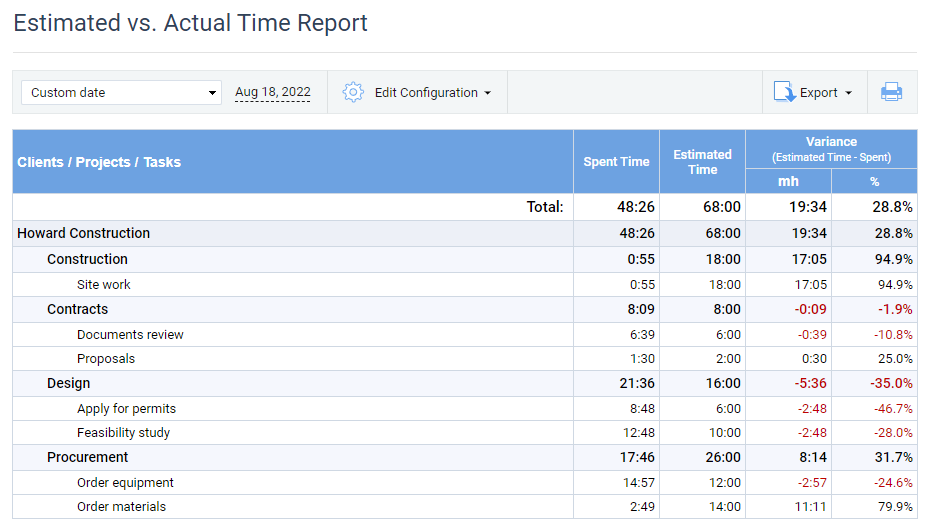
With actiTIME’s comprehensive reports, you can easily pull up historical project data and compare it with your current project scope:
- Dive into the time and cost tracking archives of previous projects,
- Pinpoint what worked,
- And identify areas where timelines and budgets went off track.
By recognizing patterns and relying on tried-and-tested timelines and resource allocations, you’ll gain valuable insights and create more realistic estimates for upcoming projects – because history tends to repeat itself!
2. Use the critical path method (CPM)
At its core, the CPM helps you pinpoint the essential tasks that must be completed on time for the project to finish smoothly. By focusing on these critical tasks, you can allocate resources more efficiently and avoid unnecessary delays.
It’s like playing chess – knowing which moves are vital helps you strategize better and, in turn, saves you money. Plus, the CPM provides clear insights into which activities can be delayed without impacting the overall timeline, giving you the flexibility to tweak and optimize as needed.
How to define your project’s critical path:
- First things first, jot down every single task that needs to be done to complete the project. No task is too small to include! This ensures you have a comprehensive starting point.
- Next, estimate how long each task will take. Be realistic here – nothing kills a project faster than overly optimistic timelines!
- Now, figure out the dependencies. Which tasks need to be finished before others can start? Think of this as lining up dominoes – each one knocks down the next.
- With your tasks and dependencies at hand, it’s time to create a network diagram. This visual map will help you see how tasks flow from start to finish.
- Find the longest path from the project’s start to its finish. This is your critical path, the chain of tasks that dictates your project’s timeline. If any task on this path is delayed, the entire project will be delayed.
- Once your critical path is defined, keep a close eye on these tasks. Things change, and being adaptable is key. Adjust as needed to keep everything on track.

Plan out your project and create a comprehensive list of tasks (with deadlines and priorities) using actiTIME’s work scope management features.
3. Track work progress in real time
Real-time progress tracking means you know exactly where your project stands at any given moment – no more guessing games or waiting for weekly updates. By keeping tabs on real-time data, you can spot issues before they snowball, pivot quickly when things go off course, and keep everyone on the same page.
This all translates to big-time savings due to fewer delays, less rework, and more efficient use of resources. Your team stays focused, and your budget doesn’t get eaten up by unexpected hiccups.
How to track work progress effectively:
actiTIME offers a comprehensive set of features for effortless and accurate progress tracking:
- Manual time tracking. Use weekly timesheets to record how much time each task consumes or switch to the Calendar View to record the exact start and end times of their daily work activities.
- Time Management Assistant. This automated browser extension runs seamlessly in the background, capturing every website visited and app used without any manual input. This means you get a comprehensive and precise account of your time spent online, freeing you up to focus on your work instead of tracking it.
- Mobile app. It lets you track tasks with a single tap on the screen and visually assess your productivity via intuitive charts. Whether you’re at a remote site or simply away from your desk, maintaining an accurate record of your activities has never been easier.
- Kanban board. By organizing tasks into columns representing different stages of the process, this feature helps you track progress, identify bottlenecks, and allocate resources more efficiently. It’s an excellent tool for anyone who loves a visual approach to workload management.
- Visual progress bars. These allow you to see, at a glance, how close you are to completing your tasks. These bars fill up as you progress, providing a quick and satisfying way to measure your performance against the set estimates.
- Real-time widgets. They give you live updates on your time tracking summaries. By embedding these widgets into your dashboard, you have instant access to key resource usage trends without having to dig through reports. This real-time feedback helps in making swift decisions to stay on track.
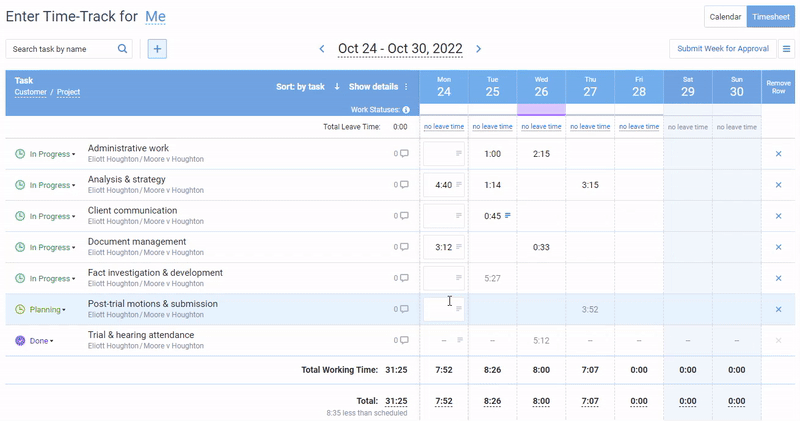
Sign up for a free actiTIME trial to experience the above features firsthand.
4. Keep your budget under control
If you’re managing a project without keeping a keen eye on the budget, it’s almost like trying to steer a ship without a compass. You might get where you’re going, but there’s a good chance you’ll waste time and resources along the way.
By diligently monitoring expenses and keeping everything within the predetermined budget limits, you not only avoid overspending but also uncover areas where you can save money. This could mean switching to more cost-effective suppliers, reallocating resources efficiently, or identifying and addressing potential financial waste early on.
How to control your budget:
- Track expenses regularly. Consistent cost monitoring is key to better budget control. So, use actiTIME’s detailed cost tracking reports to review your staff-related expenditures frequently. These reports provide a clear snapshot of where your money is going, helping you identify potential cost-saving opportunities and adjust your spending habits before they escalate into bigger issues.
- Set clear budget boundaries. Clearly define your budget limits at the outset of your project. Assign specific budgets (estimates) to different phases or tasks. Then, set up notifications for budget overruns in actiTIME. This feature will alert you whenever you’re nearing your budget limit, allowing you to take swift corrective actions and avoid going overboard.
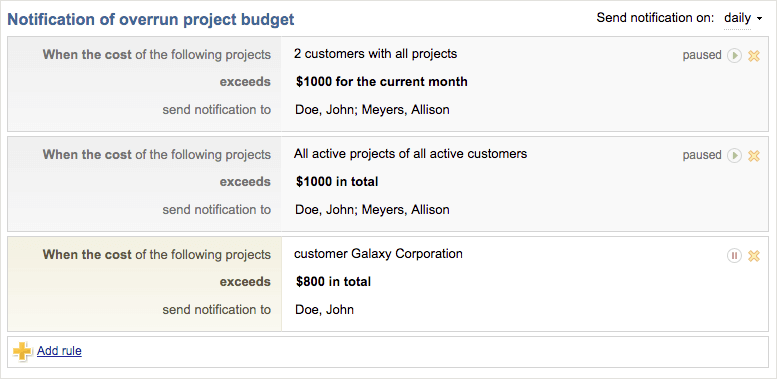
Track staff-related expenses, compare them to project revenues, and invoice clients the easy way with actiTIME.
5. Assess risks
By identifying risks early, you can plan strategically to avoid them or minimize their impact. This way, you’ll not only avoid expensive damage but also save time and resources, which means a healthier budget overall.
Think of it as preventive maintenance for your project – you’re not just putting out fires, you’re making sure they don’t start in the first place.
How to assess and prevent project risks:
Risk assessment can be either quantitative or qualitative. While the former aims to assign objective numerical scores to each risk, the latter implies a more general and subjective assessment.
We’ve explained how they work and made free templates for both types of risk assessment – they are up for grabs here.
6. Measure resource utilization
When you know exactly how your resources – your team’s time, equipment, or budget – are being used, you can easily spot inefficiencies and areas where you’re overspending.
For example, if you notice that certain team members are consistently overloaded while others are underused, you can redistribute tasks to balance the workload. This not only boosts productivity but also ensures that you’re getting the maximum value out of every resource.
Moreover, by keeping an eye on utilization rates, you’re in a better position to forecast future project needs and avoid unnecessary expenditures. Essentially, it’s all about smarter allocation and getting more bang for your buck.
How to measure resource utilization:
Your resource management outcomes depend a lot on which metrics your use to analyze your resource utilization. We’ve listed the 7 most common of them in this post – make sure to check it out!
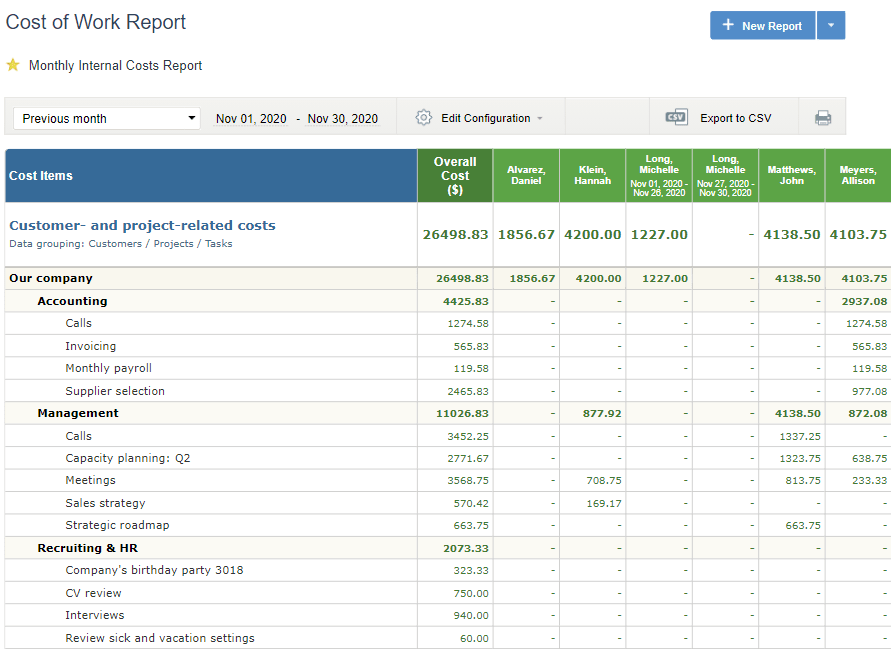
Use actiTIME reports to analyze your resource utilization in depth and cut costs in project management.
7. Prevent scope creep
In project management, scope creep refers to those unplanned additions that sneak their way into the project, causing delays, adding costs, and often turning a well-organized plan into a chaotic mess.
Thus, preventing scope creep is key to cutting costs because each new feature or requirement usually comes with its own set of expenses – think additional hours, more materials, and sometimes even new team members. By nipping scope creep in the bud, you keep the project’s original budget and timeline intact.
How to prevent scope creep:
- Get everyone on the same page before you even start. Gather all your stakeholders and define what success looks like – nail down the project scope, deliverables, and timelines. Think of this as drawing a map – the clearer the path, the less likely anyone is to wander off-track.
- Keep communication channels open and buzzing. Regular updates and check-ins with your team and stakeholders help ensure everyone knows where the project stands and can voice concerns or changes early. It’s like keeping a tight-knit community – when everyone talks, nothing catches you off guard.
- Control change requests. Not all changes are bad, but they need to be managed. Set up a solid change request process where any proposed changes must go through an evaluation to see their impact on time, cost, and scope. This keeps the project flexible but prevents it from morphing into something unrecognizable.
8. Analyze costs against benefits
Cost-benefit analysis is all about making sure the resources you’re pouring into a project actually translate into tangible results. For instance, if a particular task is gobbling up funds without adding significant value, it’s a clear sign that adjustments are needed.
This method doesn’t just trim the fat – it ensures that every dollar spent is a dollar well-invested, leading to more efficient project execution and a healthier bottom line.
How to carry out the cost-benefit analysis:
- Identify the scope of your project. You need to gather all the details about your project – what exactly are you trying to achieve, and what are the various components involved? This clarity will serve as the backbone for your analysis.
- List all the costs. This includes everything from direct costs, like materials and labor, to indirect costs, such as utilities and rental space. Don’t forget about those sneaky hidden costs, like potential downtime due to unplanned staff absences, etc.
- Tally up all the benefits. What positive outcomes do you expect from this project? Increased revenue, improved customer satisfaction, or perhaps enhanced market presence? Assign a monetary value to these benefits to make them quantifiable.
- Compare costs and benefits. Subtract the total costs from the total benefits. The result is your net benefit. If your net benefit is positive, you’re looking at a project that’s likely worth pursuing.
- Evaluate non-monetary factors. Some benefits, like improved team morale, don’t have a direct dollar value but can significantly impact your project’s success. Weigh these alongside your net benefit to get a comprehensive view.
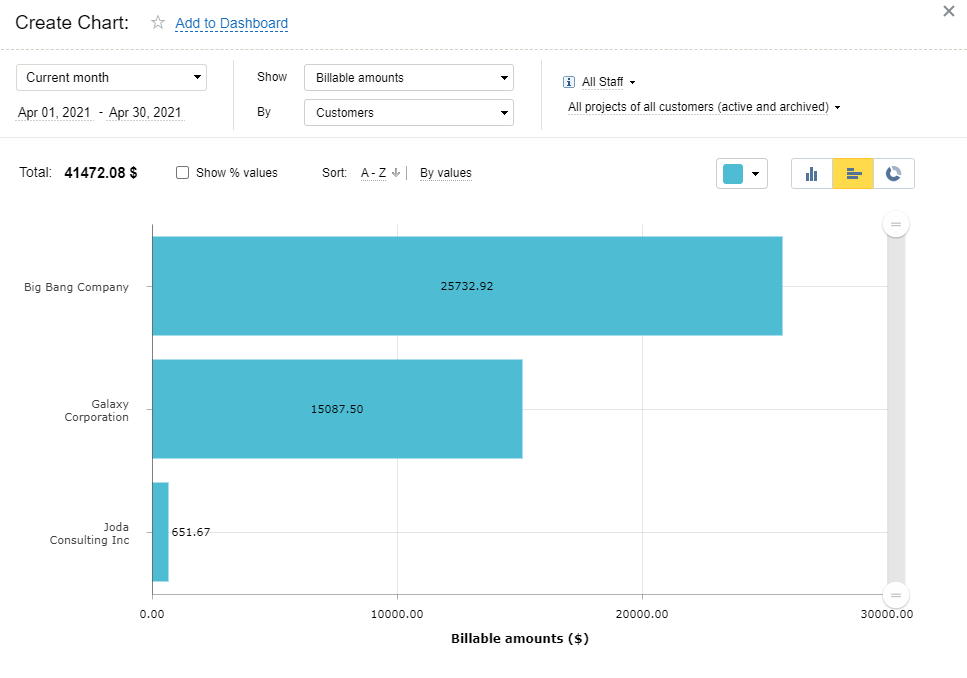
Analyze staff-related costs against hourly revenues via actiTIME reports and make sure your projects bring the desired financial results.
9. Practice lean project management
At its core, lean project management is all about maximizing value while minimizing waste. It encourages you to focus on what’s truly essential, thus helping you streamline processes, cut out inefficiencies, and make smarter use of resources. In other words, no more sinking money into tasks that don’t add real value.
Plus, this approach fosters a culture of continuous improvement, so your team is always on the lookout for tweaks that save time and money. It’s like having a built-in savings plan for every project you tackle.
How to apply lean project management:
- Identify value. Get clear on what really matters. Talk to your stakeholders and understand what they see as valuable. It’s like discovering the hidden treasures of their needs and wants.
- Map the value stream. This is where you draw out the entire process, from start to finish. Think of it like making a treasure map where X marks the spot, showing where you can find and eliminate waste.
- Optimize workflows. Smooth out the process so the path from start to end is as direct as possible. Imagine it’s like creating a fast lane on a highway, removing any speed bumps or detours that slow you down.
- Establish pull. This step is about ensuring that work only starts when there is a concrete demand for it. Picture a sushi bar where the chef only makes the rolls when someone orders them, ensuring everything is fresh and in demand – that’s how you need to approach work as well.
- Seek perfection. This means continuously looking for ways to improve. It’s like being on a never-ending quest for the ultimate efficiency, always asking how you can do things better.
10. Master workforce capacity planning
Workforce capacity planning empowers you to know exactly how many hands you need on deck and when. This savvy approach allows you to prevent overstaffing, which can drain your budget with unnecessary payroll expenses. Conversely, it helps you avoid understaffing, which can lead to costly project delays.
By ensuring the right balance, you maximize your team’s productivity without burning money on idle hands or missed deadlines.
How to plan out workforce capacity:
We’ve made a comprehensive guide on workforce capacity planning, which covers all the relevant strategies, tools, and techniques. Check it out here.
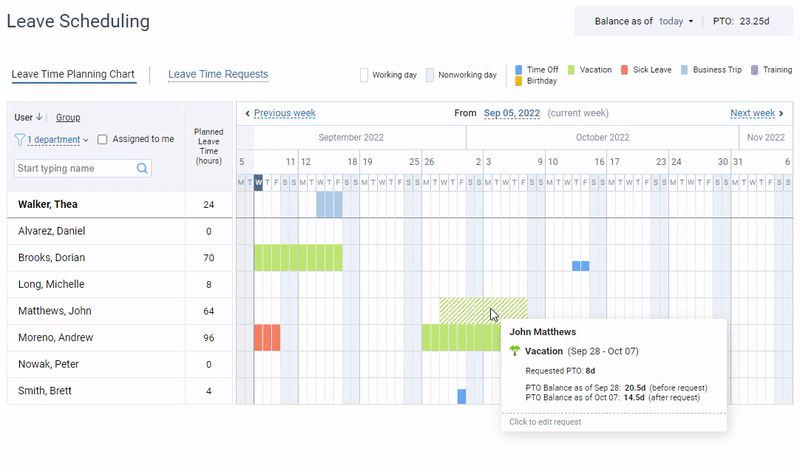
Use actiPLANS to schedule employee absences in a few clicks and plan out project activities on an intuitive visual timeline.
Conclusion
And there you have it – some straightforward yet effective ways to cut costs in project management. By implementing these strategies, you’ll not only keep your projects within budget but also streamline your processes and boost overall efficiency.
Ready to take your cost-saving efforts to the next level? Give actiTIME a try for all your time and cost tracking needs. It will help you collect accurate data for in-depth cost analysis, empowering you to enhance efficiency and maximize financial gains.












































